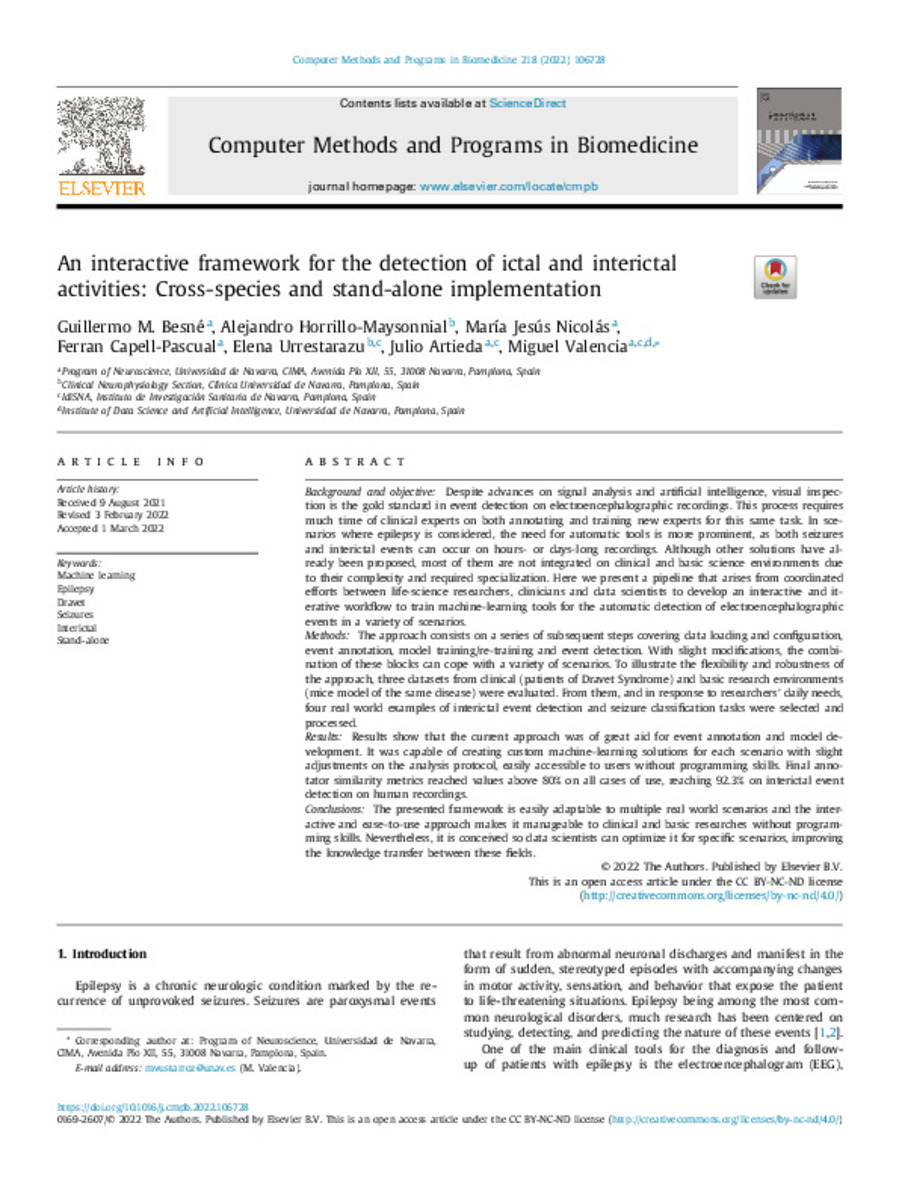Full metadata record
| DC Field | Value | Language |
|---|---|---|
| dc.creator | Besne, G. (Guillermo) | - |
| dc.creator | Horrillo-Maysonnial, A. (Alejandro) | - |
| dc.creator | Nicolas, M.J. (María Jesús) | - |
| dc.creator | Capell-Pascual, F. (Ferran) | - |
| dc.creator | Urrestarazu, E. (Elena) | - |
| dc.creator | Artieda, J. (Julio) | - |
| dc.creator | Valencia, M. (Miguel) | - |
| dc.date.accessioned | 2022-06-29T10:37:15Z | - |
| dc.date.available | 2022-06-29T10:37:15Z | - |
| dc.date.issued | 2022 | - |
| dc.identifier.citation | Besne, G. (Guillermo); Horrillo-Maysonnial, A. (Alejandro); Nicolas, M. J. (María Jesús); et al. "An interactive framework for the detection of ictal and interictal activities: cross-species and stand-alone implementation". Computer Methods and Programs in Biomedicine. (218), 2022, 106728 | es_ES |
| dc.identifier.issn | 0169-2607 | - |
| dc.identifier.uri | https://hdl.handle.net/10171/63739 | - |
| dc.description.abstract | Background and objective: Despite advances on signal analysis and artificial intelligence, visual inspec- tion is the gold standard in event detection on electroencephalographic recordings. This process requires much time of clinical experts on both annotating and training new experts for this same task. In sce- narios where epilepsy is considered, the need for automatic tools is more prominent, as both seizures and interictal events can occur on hours- or days-long recordings. Although other solutions have al- ready been proposed, most of them are not integrated on clinical and basic science environments due to their complexity and required specialization. Here we present a pipeline that arises from coordinated efforts between life-science researchers, clinicians and data scientists to develop an interactive and it- erative workflow to train machine-learning tools for the automatic detection of electroencephalographic events in a variety of scenarios. Methods: The approach consists on a series of subsequent steps covering data loading and configuration, event annotation, model training/re-training and event detection. With slight modifications, the combi- nation of these blocks can cope with a variety of scenarios. To illustrate the flexibility and robustness of the approach, three datasets from clinical (patients of Dravet Syndrome) and basic research environments (mice model of the same disease) were evaluated. From them, and in response to researchers’ daily needs, four real world examples of interictal event detection and seizure classification tasks were selected and processed. Results: Results show that the current approach was of great aid for event annotation and model de- velopment. It was capable of creating custom machine-learning solutions for each scenario with slight adjustments on the analysis protocol, easily accessible to users without programming skills. Final anno- tator similarity metrics reached values above 80% on all cases of use, reaching 92.3% on interictal event detection on human recordings. Conclusions: The presented framework is easily adaptable to multiple real world scenarios and the inter- active and ease-to-use approach makes it manageable to clinical and basic researches without program- ming skills. Nevertheless, it is conceived so data scientists can optimize it for specific scenarios, improving the knowledge transfer between these fields. | es_ES |
| dc.description.sponsorship | Authors acknowledge financial support from CureDravet E-rare project from EU, Inocente-inocente Foundation and Instituto de Salud Carlos III “DTS19/00130′′. (Co-funded by European Regional Development Fund; “A way to make Europe”). GB is a recipient of an ADA (Asociación de Amigos de la Universidad de Navarra) fellowship. | es_ES |
| dc.language.iso | eng | es_ES |
| dc.publisher | Elsevier | es_ES |
| dc.rights | info:eu-repo/semantics/openAccess | es_ES |
| dc.subject | Machine learning | es_ES |
| dc.subject | Epilepsy | es_ES |
| dc.subject | Dravet | es_ES |
| dc.subject | Seizures | es_ES |
| dc.subject | Interictal | es_ES |
| dc.subject | Stand-alone | es_ES |
| dc.title | An interactive framework for the detection of ictal and interictal activities: cross-species and stand-alone implementation | es_ES |
| dc.type | info:eu-repo/semantics/article | es_ES |
| dc.description.note | This is an open access article under the CC BY-NC-ND license | es_ES |
| dc.identifier.doi | 10.1016/j.cmpb.2022.106728 | - |
| dadun.citation.number | 218 | es_ES |
| dadun.citation.publicationName | Computer Methods and Programs in Biomedicine | es_ES |
| dadun.citation.startingPage | 106728 | es_ES |
Files in This Item:
Statistics and impact
Items in Dadun are protected by copyright, with all rights reserved, unless otherwise indicated.






